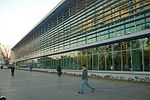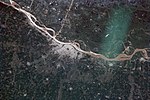Rosario Oeste railway station
Railway stations in Rosario, Santa FeRailway stations opened in 1917

Rosario Oeste is a railway station in Rosario, province of Santa Fe, Argentina. It is located in the west of the city, on the junction of Paraná St. and 9 de Julio streets. The station, part of the Belgrano Railway network, is currently operated by State-owned company Trenes Argentinos Cargas that runs freight trains to the north of Argentina.
Excerpt from the Wikipedia article Rosario Oeste railway station (License: CC BY-SA 3.0, Authors, Images).Rosario Oeste railway station
Mendoza, Rosario Azcuénaga (Distrito Noroeste)
Geographical coordinates (GPS) Address Nearby Places Show on map
Geographical coordinates (GPS)
| Latitude | Longitude |
|---|---|
| N -32.9422 ° | E -60.69285 ° |
Address
Mendoza 5001
S2008 Rosario, Azcuénaga (Distrito Noroeste)
Santa Fe, Argentina
Open on Google Maps










